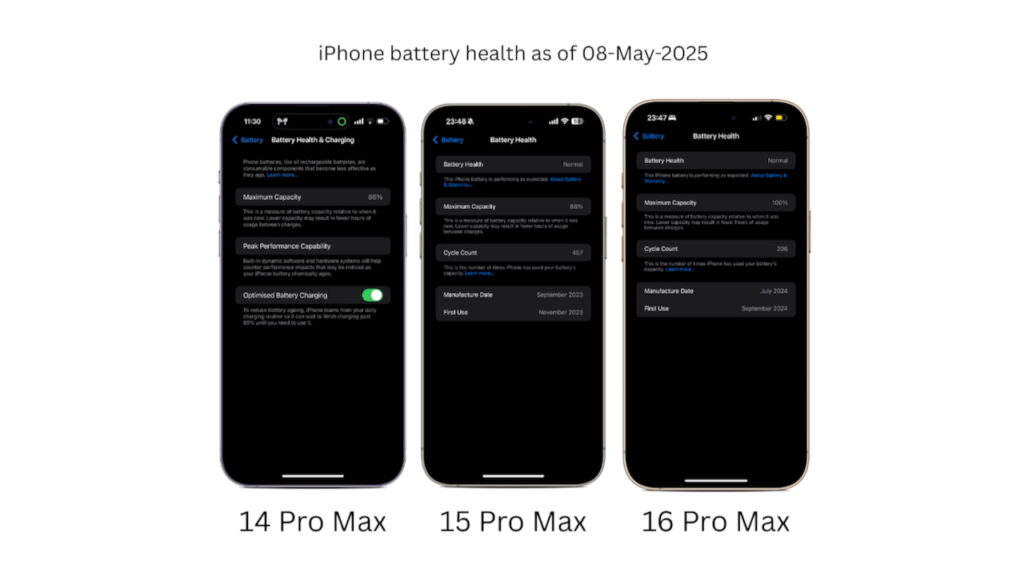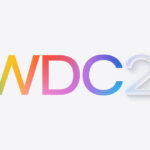Ever since Apple started showing battery health on iPhones, people have been obsessed with tracking this number. I didn’t really care about the health of my batteries but since the iPhone 14, I have been keeping an eye on this, although not obsessively. The iPhone 16 Pro Max, which I’ve been using since launch day, has easily been the healthiest battery I have. I do not know if this is purely based on luck or if Apple made improvements to the battery on the iPhone 16 Pro Max to enhance battery longevity or health.
If you look online, people love discussing their battery health after a certain amount of use. Reddit is full of posts like, “Is this a good battery health?”, “Why did my battery health drop to 99% after only 85 charge cycles?” After seven months of using the 16 Pro Max, my battery is still at maximum, aka 100%, at 206 cycles. For context, this is how my previous two iPhones fared when it came to battery health:
iPhone 14 Pro Max:
- 100% on launch day
- 88% when I sold the phone a week after the release of the 15 Pro Max
- 86% today (I messaged the person who purchased my phone to ask what it was like)
iPhone 15 Pro Max:
- 100% on November 2023
- 94% when I sold the phone a week after the release of the 16 Pro Max
- 88% today (My wife has this phone so I just checked!)
- 457 Charge cycles
- This phone still has the hard cap on charging to stop at 80%

Some things to note:
- I did get my 15 Pro Max on launch day, but Apple gave me a replacement brand new phone a month later for reasons not really interesting. Hence the November 2023 date above.
- I can’t remember the battery percentage of my older iPhones seven months into their lifecycle, but I do recall that they had dropped from 100% around this time. Will my iPhone 16 Pro Max stay at 100% for eight months and then experience a sudden drop to levels lower than these? Only time will tell.
- After a year, the rate of battery deterioration slowed down on the 14 Pro Max, but not really on the 15 Pro Max.
- The 15 Pro Max was at 94% after a year, compared to 88% on the 14 Pro Max. There’s no way to determine whether I simply received a better battery or if Apple made actual improvements to battery design.
- Speaking of Apple potentially improving the battery on the 15 Pro Max—it was the first iPhone to offer the option to limit battery charging to 80%. That likely helped maintain better battery health. (To be clear, this is not the Optimised Battery Charging feature introduced in iOS 13, but a new setting that actually prevents the iPhone from charging beyond 80%.)
- The 15 Pro Max did experience some general overheating issues, but fortunately, my unit was never affected as I wrote about it at the end of it’s tenure.
- The iPhone battery cycle count is only available on iPhone 15 and newer models (on the iOS settings app that is, there are third party apps that can get you this number.)
Here’s how I charge my device. I acknowledge that this is not scientific, and I do not know if it actually makes a difference, but it has definitely helped with maintaining the battery health on my iPhone:
With the 16 Pro Max (and the 15 Pro Max before this), I set the charging limit to 80%, meaning the phone wouldn’t charge beyond 80% most of the time. This is how my phone has been unless I’m on holiday or if I know I need my battery to be at a higher percentage for a full day out or an extended photography session.
At night, I place my phone on my MagSafe Duo charger next to my bed. In the morning, when I wake up, my phone is at 80%, and I use it throughout the day. If needed, I will prop it up a little here and there. I have the Belkin MagSafe charger at my work desk where I occasionally place it. I rarely plug my phone in directly; the only times I do are when I’m out and about with an external battery pack. I can bet my phone has been charged via the port less than 5% of the time I have had it.
The switch to USB-C a few years ago didn’t make much of a difference for me personally because I have always used MagSafe to charge my iPhones. This includes the iPhone 16 Pro Max I use now, the iPhone 15 Pro Max, and the 14 Pro Max that I have used before. There is a theory that MagSafe charging, due to the heat it generates, could deteriorate the battery further. However, in my case, I don’t believe this to be true, as my battery health is still at 100% as we speak – at least on my 16 Pro Max. Was it what let the battery on the 14 Pro Max and 15 Pro Max deteriorate faster? I don’t know. But my charging habits haven’t changed in the last few years. It’s been MagSafe 90% of the time, so I can only assume that Apple did something right with the iPhone 16 Pro Battery.
I don’t tend to monitor battery health too closely, as I know I’ll likely get the next iPhone when it’s released. However, there seems to be an unhealthy obsession online with tracking battery health. I understand why people do it, especially if they’ve spent a significant amount on a phone and plan to use it for five or more years. After all, they’ve paid for it. In that case, I’d probably track it religiously too. But I think obsessing over that number—if it takes away from the enjoyment of using the phone—is pointless.
With the 16 Pro Max, I feel fortunate to have a good battery, and even if I didn’t, it wouldn’t take away from how much I enjoy this phone. If Apple has made improvements to the battery or thermals to slow down battery deterioration, I hope they continue building on that in future models.


